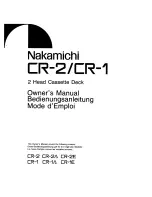13
AAC (Advanced Audio Coding)
Also called MPEG-2 AAC or MPEG-2 NBC, this audio codec is the logical continuation of the MP3 codec created by
Fraunhofer-Gesellschaft. Due to advances in technology, AAC files encoded at a 96 kbps bit rate sound slightly
better than MP3s encoded at 128 kbps.
The AAC codec entered the mainstream when Apple announced that the iTunes Music Store would sell its digital
music downloads in AAC format. Copy protected AAC files are not supported by this player.
WAV or WAVE
A format developed by Microsoft and IBM for storing high quality, uncompressed audio. WAV became the standard
on PCs, but because of the large file sizes it requires (about 10MB per minute of music), most people convert WAV
files to compressed formats (MP3, WMA, and so on).
WMA
Windows Media Audio is a ‘lossy’ format similar to MP3 and AAC. This is essentially a competing format created
and licensed by Microsoft. Microsoft claims that Windows Media files are even better than MP3 files, and is now
positioned as a competitor to the AAC format.
* A file extension on a file (such as .avi) does not mean that the data within that file is compatible with the player. Many file formats use similar file extensions, and
it is not necessarily an indication of what the file encoding format is. HD MediaBox supports many types of file format, but due to encoding differences, not all files
may play.
1.4.3
A Brief Overview of Photo Formats
JPEG and JPG
JPEG (pronounced jay-peg) is by far the most commonly used method of compression for photographic images.
Although a ‘lossy’ format, most digital cameras are able to save files at a compression level hard to detect. Overly-
compressed files can suffer from artifacts such as ‘blocking’, ‘smearing’ and ‘blurring’. These are similar to those
found in low bit rate DVDs and Video CDs.
BMP
The name is short for bitmap and these files can be saved at various bit-depths. This relates to the number of colours
shown in the image and is commonly saved at 24-bit (referred to as true-color). 24-bit BMP files are lossless but are
much larger in file size than JPEGs. These files are used internally by the Microsoft Windows graphics subsystem (GDI).
GIF
These are very common on the Internet and mostly used for line art and areas of flat colour (logos, buttons and
diagrams for example). GIF files keep edges clearly defined, but JPEG is much better for photographic images
PNG
PNG (Portable Network Graphics) is a lossless compressed bitmap image format. PNG was created to both improve
upon and replace the GIF format with an image file format not requiring a patent license to use. PNG is officially
pronounced "ping" and, like GIFs and BMPs, reduces file size by reducing the number of colours. PNGs can also be
24-bit true-color and maintain all the original image information, similarly to BMPs though, file sizes will be large.
Common file extensions*
.wma
Streaming over the 100BASE-T and USB2.0 supported
YES
Common file extensions*
.wav
Streaming over the 100BASE-T and USB2.0 supported
YES
Common file extensions*
.aac .m4a
Streaming over the 100BASE-T and USB2.0 supported
YES


















